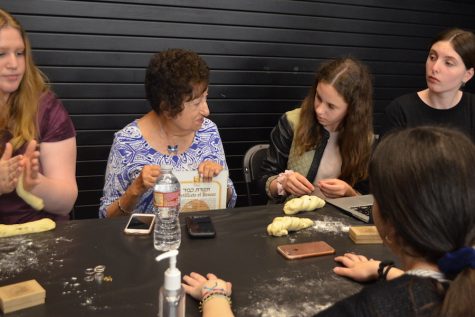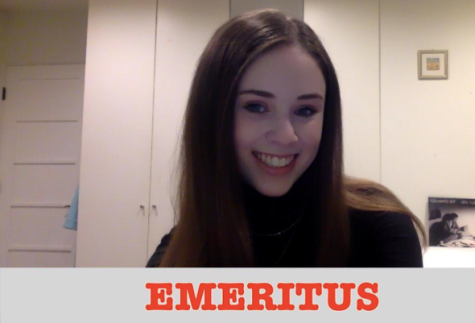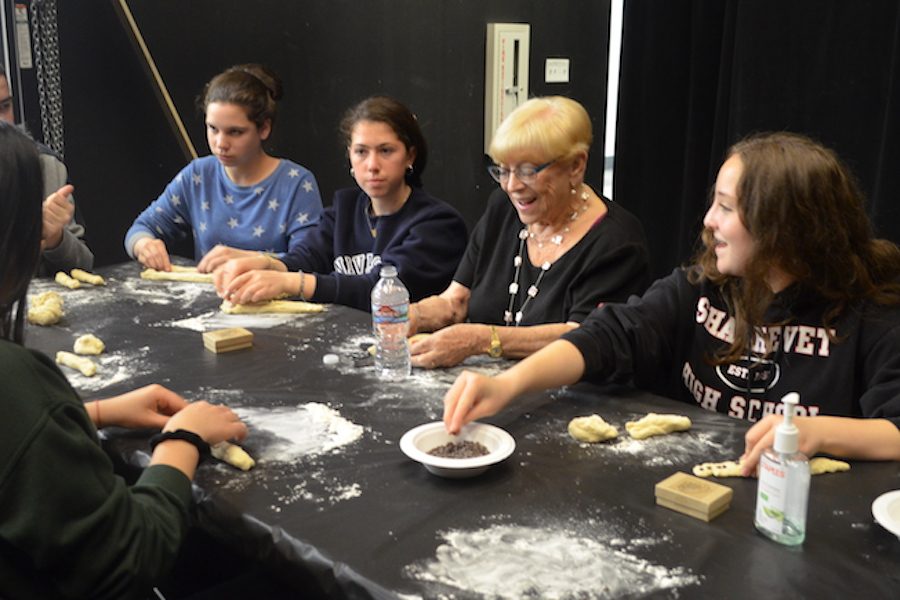‘La Dough Va Dough’ event weaves challah and history
Holocaust survivors share their stories while making challah with students in Wildfire Theater
BRAID: Ms. Yona Nadelman, second from right, described her Holocaust experiences while making bread with students in the Wildfire Theater May 17. The event was sponsored by the Los Angeles Museum of the Holocaust and led by Shalhevet sophomore Noa Nelson.
Holocaust survivors and high school students braided challah together in the Shalhevet theater last week, sharing the life-changing events of World War II in a means they hoped neither would forget.
The event was called “La Dough Va Dough,” a pun on the Hebrew expression l’dor vador which means “from generation to generation.” Sophomore Noa Nelson, one of the organizers, said it was put together with the idea that students would learn more about the Holocaust in an environment away from textbooks.
Additionally, she said, braiding challah is a tradition that both generations can bond over.
״It’s not so much that the challah has anything to do with the Holocaust,” said Noa. “It’s more that braiding the challah creates an open new environment for the survivors and students to share and connect.”
Three survivors — Martha Sternbach, Yona Nadelman and Gabriella Karin — were there, and each shared her story with one third of the group, which was divided among three tables for the May 17 lunch. The event was organized by Noa, sophomore Emma Mackler and junior Jonathan Fishman, all of whom are on the teen advisory board at the Los Angeles Museum of the Holocaust.
Ms. Karin, who spent the war hidden with her family in a small apartment in Slovakia, has spoken all over including Yad Vashem in Israel and at the United States Holocaust Memorial Museum in Washington D.C. She also has gone on the March of the Living trip seven times and been featured in multiple publications, including the Los Angeles Times and as a cover story of the Jewish Journal.
“It was nice to speak to a small group,” Ms. Karin said.
Ms. Karin is also a sculptor. Her work can be found in Los Angeles Museum of the Holocaust, the Museum of Tolerance, the Slovakia Holocaust museum in Bratislava, and museums in Warsaw, Krakow and elsewhere.In 2017, she was awarded a Certificate of Appreciation from the city of Los Angeles for “her dedication to preserving the memory of the Holocaust,” according to her website.
Students listened intently as she led them through her journey which could only be described as miraculous. She grew up in Slovakia — a strategic partner of Germany, so deportations were managed by Slovakians themselves rather then by Germans. According to Ms. Karin, there were 90,000 Jews living in Slovakia and two-thirds of them were deported. Of those 60,000, only 230 people returned.
Her family was not deported. When she was 11, her parents put her in a boarding school convent run by nuns, where she stayed for three years.

Ms. Gabriella Karin, second from left, shares memories of World War II with students at her table braiding challah. She is also a professional sculptor.
“I learned all the Christian prayers, I went to mass everyday, and I cried myself to sleep every night,” Ms. Karin said. “About a year later my mother came, and when she saw my cried-out eyes and my skinny face, she decided for the night she will take me wherever she is and in the morning I will come to school. This is what I did for the next two years.”
Ms. Karin’s mother worked with the underground, a secret organization that helped Jews during the Holocaust. She said her mom went to Hungary and warned the people about the Germans, but they didn’t listen. Three days later, Germany occupied their country.
When her mom discovered that Slovakia would soon be occupied as well, her family went into hiding in the one-bedroom apartment of a 25-year-old non-Jewish lawyer named Karol Blanar. There were eight people hiding in that home.
One day Gabriella saw two girls from the convent — which was in close proximity to her hiding location — get caught in the street. She never saw them again.
Ms. Karin stayed in Mr. Blanar’s home for nine months. All she was able to do there was read the books he brought her — long, serious books which were not written for a pre-teen.
“Can you imagine yourself for nine months sitting on a chair not being able to move around and not being able to speak, a whole school year!” she exclaimed. “The only thing I could do was to read, and I was reading 14 hours a day.”
This turned out to be a good thing, she added.
“Everything can be taken away from you, even the clothes you wear,” Ms. Karin said. “But nobody can take away from you what you have in your head.”
She showed the seated students two pictures, one of which showed her smiling happily at age six, the other with a straight face because that was during the war, when she was just 11 years old. In her notebook there was also a picture of her 10th birthday party, where she was surrounded by a few of her close friends. According to Gabriella, None of them survived.
After the war was over, she went back to the railroad station hoping to find a familiar face as trains with survivors came in. She did not recognize anyone. She was 14 years old.
At first, she didn’t know how she would live a normal life after having gone through what she had been through.
“I decided, in myself, Hitler did not get my body and he did not get my soul,” she said.“I will smile, and I will be happy. And I am.”
Ms. Sternbach spoke about her life after the war, when she lived in New York; what her life was like before the war; and the moment her liberation.
“It was really interesting to see how positive she was after the fact that she went through all that,” said freshman Noa Silberstein, who braided dough with Ms. Sternbach. “It really gave me perspective into my life, and how the things that I get upset about are nothing compared to what she had to go through.”
Ms. Nedelman’s native city was Krakow Poland, but soon after the Natzi invasion, her family left for Lutsk, in the Soviet Sector. Her parents continued to Siberia and Yona was left with her grandparents, who arranged for her and two of her siblings to live on a farm for the duration of the war.
When it was over, her father found her.
“I recognized him and he smiled, and apparently as a child I used to touch one of his teeth which had a gold thing on it,” Ms. Nedelman said. “It was a very dramatic moment, because here they had gone when I was six years old, and he found me.”
The program drew to a close at the end of lunch, and later on in the day it was announced on Schoology that the challahs the group had made were available in receptionist Daniella Silva’s office.
Noa said the museum teen board planned to bring the dough program to all of the their schools and communities.
“Our committee decided that ‘La Dough Va Dough’ was one of the best and most engaging platforms for students to connect with Holocaust survivors,” said Noa. “It keeps students engaged, it keeps the Holocaust survivors and everyone interested.”

Molly is studying at Midreshet Torah v'Avodah seminary in Jerusalem and will attend Columbia University in New York next year.








